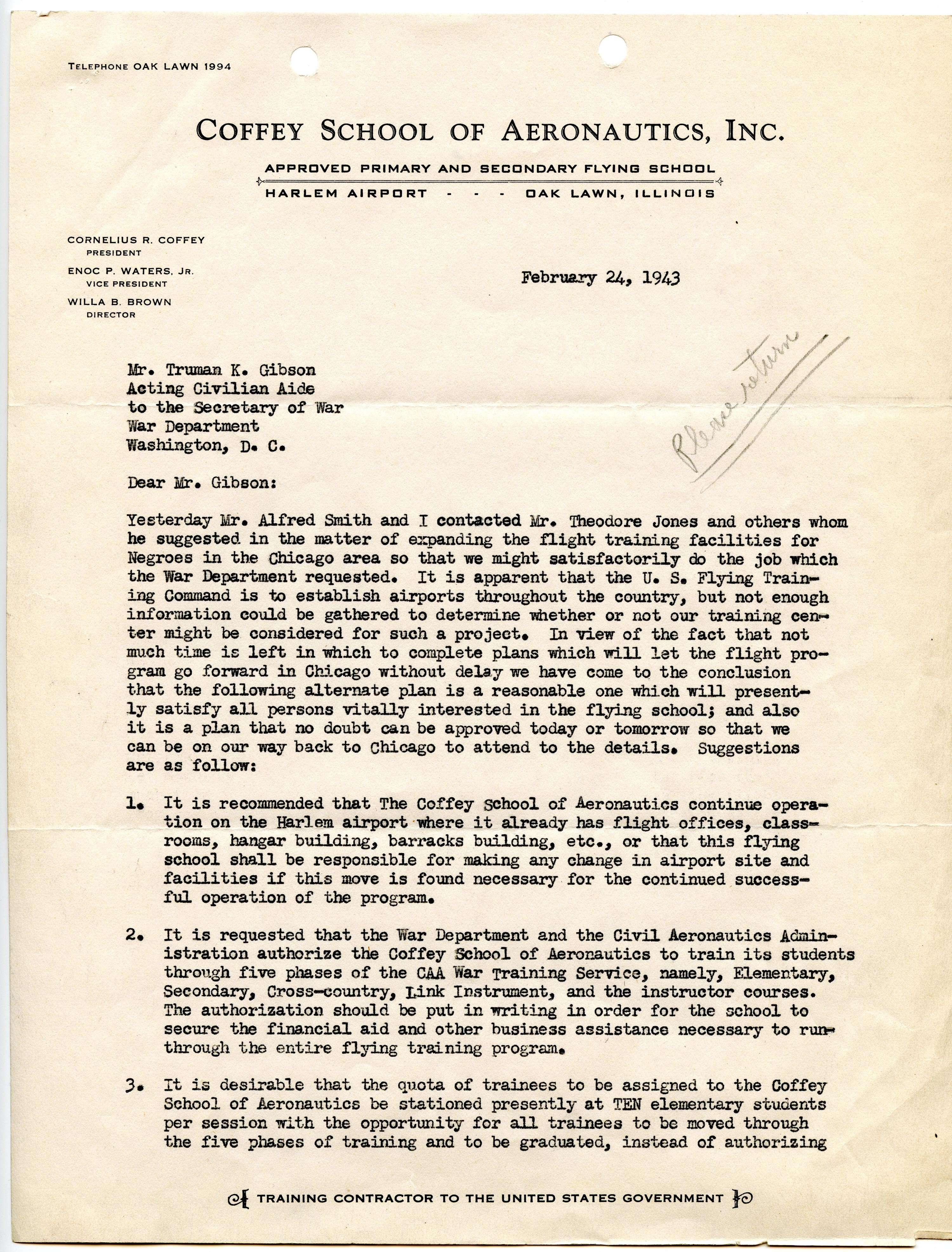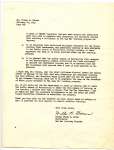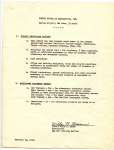Letter from Willa Beatrice Brown to Truman Gibson
2/24/1943
Add to Favorites:
Add all page(s) of this document to activity:

Add only page 1 to activity:
Add only page 2 to activity:
Add only page 3 to activity:
Willa Beatrice Brown sent this letter to Truman Gibson, Civilian Advisor to Secretary of War Henry Stimson during World War II. In it she outlined a plan for the Coffey School of Aeronautics in Chicago to train Black pilots for the U.S. Flying Training Command.
Brown was an American aviator, lobbyist, teacher, and civil rights activist. Among her many firsts, she was the first Black woman to earn her pilot's license in the United States, the first African-American woman to run for Congress (in 1946, 1948, and 1950), the first African-American officer in the U.S. Civil Air Patrol (CAP), and the first woman in the United States to have both a pilot's license and a mechanic's license.
Brown took her first flight in Chicago in the early 1930s. Within a decade, she went from flying enthusiast to aviator, flight instructor, and later officer and civil rights activist, creating a path for thousands of Black men and women to become pilots.
Brown began taking lessons at the racially segregated Harlem Airport outside Chicago, joined a Black flying club called the Aero Challenger Club, and met pilot, plane mechanic, and future husband Cornelius Coffey. From 1934 to 1937, while she trained to be a pilot, she earned her master mechanic’s certificate and a master’s in Business Administration at Northwestern University. Not long after, Brown gained her first "first" in 1938, when she became the first Black woman to be licensed as a private pilot in the United States.
In August 1937, Brown, Coffey, and ten others founded the National Airmen’s Association of America (NAAA), whose main goal was to get Black aviation cadets into the U.S. military. The group eventually included more than 2,000 members and chapters across the Midwest and East Coast.
In 1938, Brown and Coffey opened the Coffey School of Aeronautics at Harlem Airport. Their school, the first flight school owned and operated by African-Americans, was created to train Black men to fly and provide cadets to the U.S. Air Force.
When World War II began, the United States needed more pilots. Willa Brown, then 33 years old and director of the Coffey School, was ready. She was paying attention when Congress appropriated $5,675,000 for the Civil Aeronautics Authority (CAA) to begin 220 pilot training programs across the country. The Coffey School of Aeronautics was authorized as a CAA school by January 1940. Brown’s roles were director and coordinator of training.
In addition to the CAA training school, letters like this one from Brown to numerous leaders in Washington, DC, show her tireless efforts for their school to be part of the Army training program. Despite Brown’s disappointment that the Army would not allow the Coffey School of Aeronautics to train pilots for the Army, their school was selected to provide Black trainees for the Air Corps’s pilot training program at the Tuskegee Institute in Alabama. This led to the creation of the Tuskegee Airmen. Brown trained nearly 200 of the men and women who went on become cadets or instructors.
Not long after World War II, Brown and her husband closed the Coffey School of Aeronautics. But Brown's continued political work and activism contributed to a major civil rights victory in 1948, when President Harry Truman signed E.O. 9981, ending racial segregation in the military. Brown continued teaching in high schools, focusing on aeronautics and business subjects until she retired in 1971. In 1972 Brown was the first Black woman appointed to the Federal Aviation Administration’s Women’s Advisory Board and served on the board until 1974.
This letter uses the term "negro" to refer to Black people, which was commonly accepted in that era, but is outdated and inappropriate today.
Brown was an American aviator, lobbyist, teacher, and civil rights activist. Among her many firsts, she was the first Black woman to earn her pilot's license in the United States, the first African-American woman to run for Congress (in 1946, 1948, and 1950), the first African-American officer in the U.S. Civil Air Patrol (CAP), and the first woman in the United States to have both a pilot's license and a mechanic's license.
Brown took her first flight in Chicago in the early 1930s. Within a decade, she went from flying enthusiast to aviator, flight instructor, and later officer and civil rights activist, creating a path for thousands of Black men and women to become pilots.
Brown began taking lessons at the racially segregated Harlem Airport outside Chicago, joined a Black flying club called the Aero Challenger Club, and met pilot, plane mechanic, and future husband Cornelius Coffey. From 1934 to 1937, while she trained to be a pilot, she earned her master mechanic’s certificate and a master’s in Business Administration at Northwestern University. Not long after, Brown gained her first "first" in 1938, when she became the first Black woman to be licensed as a private pilot in the United States.
In August 1937, Brown, Coffey, and ten others founded the National Airmen’s Association of America (NAAA), whose main goal was to get Black aviation cadets into the U.S. military. The group eventually included more than 2,000 members and chapters across the Midwest and East Coast.
In 1938, Brown and Coffey opened the Coffey School of Aeronautics at Harlem Airport. Their school, the first flight school owned and operated by African-Americans, was created to train Black men to fly and provide cadets to the U.S. Air Force.
When World War II began, the United States needed more pilots. Willa Brown, then 33 years old and director of the Coffey School, was ready. She was paying attention when Congress appropriated $5,675,000 for the Civil Aeronautics Authority (CAA) to begin 220 pilot training programs across the country. The Coffey School of Aeronautics was authorized as a CAA school by January 1940. Brown’s roles were director and coordinator of training.
In addition to the CAA training school, letters like this one from Brown to numerous leaders in Washington, DC, show her tireless efforts for their school to be part of the Army training program. Despite Brown’s disappointment that the Army would not allow the Coffey School of Aeronautics to train pilots for the Army, their school was selected to provide Black trainees for the Air Corps’s pilot training program at the Tuskegee Institute in Alabama. This led to the creation of the Tuskegee Airmen. Brown trained nearly 200 of the men and women who went on become cadets or instructors.
Not long after World War II, Brown and her husband closed the Coffey School of Aeronautics. But Brown's continued political work and activism contributed to a major civil rights victory in 1948, when President Harry Truman signed E.O. 9981, ending racial segregation in the military. Brown continued teaching in high schools, focusing on aeronautics and business subjects until she retired in 1971. In 1972 Brown was the first Black woman appointed to the Federal Aviation Administration’s Women’s Advisory Board and served on the board until 1974.
This letter uses the term "negro" to refer to Black people, which was commonly accepted in that era, but is outdated and inappropriate today.
This primary source comes from the Records of the Office of the Secretary of War.
National Archives Identifier: 631274
Full Citation: Letter from Willa Beatrice Brown to Truman Gibson; 2/24/1943; Brown, Willa B., Coffey School of Aeronautics; General Correspondence, 1940 - 1948; Records of the Office of the Secretary of War, Record Group 107; National Archives at College Park, College Park, MD. [Online Version, https://docsteach.org/documents/document/brown-gibson-coffey, April 19, 2024]Rights: Public Domain, Free of Known Copyright Restrictions. Learn more on our privacy and legal page.






